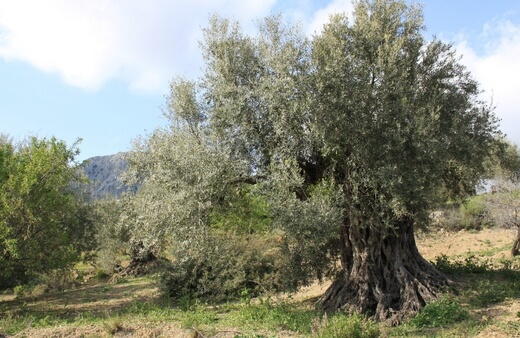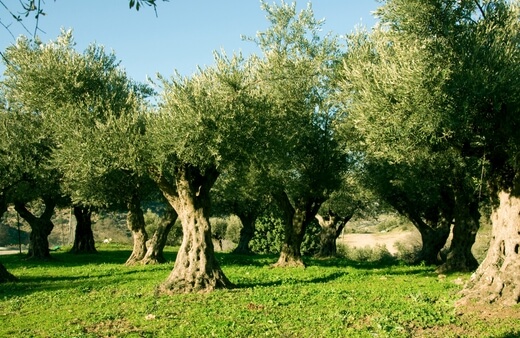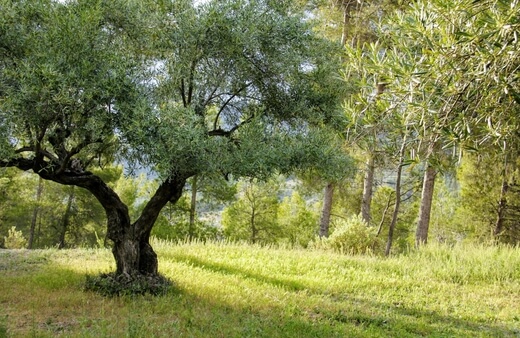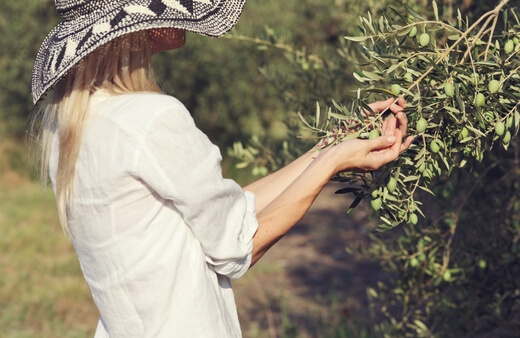Olive trees have a language of their own. Their gnarled bark, twisted trunks, and glistening, silvery, evergreen leaves are instantly recognisable. On warm days, their stems smell like ripe olives, and their leaves have a delicious odour that stays on your hands for hours.
You’ll have to travel to Europe to see olives at their best, where ancient trees are thought to be over 2000 years old in some olive groves, and mature historic trees are regularly sold at 60-100 years old, but here in Australia, our climate is perfect for supporting these magical plants, and any gardener considering one, should take the leap sooner rather than later.
I’m going to attempt to avoid gushing too heavily over olive trees, but they are captivating, and I’m completely under their spell. For everything you need to know, from seed to harvest, I’ve got you covered.
More...

Family: | Oleaceae |
|---|---|
Genus: | Olea |
Species: | O. europaea |
Common Names: | Olive tree |
Location: | Outdoor |
Type: | Evergreen tree |
Growth: | 2m tall in most settings. Can grow to 15m after several hundred years. |
Sun requirements: | Full sun |
Foliage Colour: | Silvery green |
Flower Colour: | White |
Flowering: | Spring and early summer |
Fruit: | Green, black or red fruits in summer and autumn |
Maintenance level: | Low |
Poisonous for pets: | Non-toxic to cats and dogs |
What is an Olive Tree?
Olive trees are grown for their fruit, the oil that’s extracted from it, and their stunningly beautiful timber. Olive trees have unique bark that twists and gnarls as it ages, and heals over its wounds in dramatic nodules.
In a perfect growing situation (with no wind, no pests and no wildlife – an impossible scenario) olives would grow into a 15m tall lollipop form, but they are much more likely to develop into 2-3m tall trees, with twisting limbs and wide branching canopies.

Natural Habitat of Olea europaea
Olive trees are Mediterranean native plants, and are synonymous with Greek and Italian cuisine. They grow on rich, sandy or chalky soils, with high mineral content, and steady drainage. Their roots are deep and fibrous and make the most of heavy rainfall before long sunny spells.
That Mediterranean climate is very similar to the climate of southern Australia, and not dissimilar to Eastern Australia either, so gardeners all over the country can usually find space to plant olive trees with great success.
How to Grow Olive Trees in Australia
Growing your own olives is really simple, but it's not a fast process. Olive trees won’t produce any fruit until they are at least three years old, but in most cases, don’t produce a significant harvest until they are at least ten or fifteen.
If you’re after a quick harvest, buy a mature tree, and follow the guide below to prepare its planting space.
Soil
Olive trees need mineral-rich, well-drained soil, and plenty of irrigation to support healthy growth. They are drought tolerant, but heavy prolonged droughts will result in reduced harvests, or no fruit at all, so enrich your garden soil with a mix of sand or chalk and plenty of well-rotted horse manure before planting.
Dig a hole at least twice the size of the root ball (for established olive trees, these can often be over a metre across), and aim for a square hole to encourage lateral root growth, rather than spiralling growth.
Loosen the soil at the base of the planting hole, and drive your garden fork down to improve drainage even further, unless you have incredibly sandy soil.
Light Requirements
Olive trees need full sun, so should be planted in a spot that receives 6-8 hours of direct light per day, even in winter. If planted in pots, young olive trees can be moved easily around the garden throughout the year for the best light conditions.
Watering Needs
Olive trees, despite their ability to cope with drought, really do like plenty of moisture where possible, but it's important that it can flow freely away and is never left sitting around the base of the plant.
Ideally, you should give your olive tree 2-3” of water per week, more in eastern or northern Australia. But, when in doubt, underwater rather than over water.
Temperature
Olive trees aren’t fussy about temperatures and are frost tolerant over winter once their trunk reaches 3” across. For the first four or five years, it is best to protect your olive tree from frost by mulching the base (leaving 2” or clear space around the trunk), and wrapping the canopy in fleece. If your olive is in a container, and small enough to move, store it in the greenhouse over winter.
Growing Olive Trees in Pots

While olive trees can grow to 15m tall, they rarely do, so it's quite possible to grow mature olive trees in pots and raised beds. For extremely free-draining soil or heavy clay, it's often a good idea to create a raised bed in which to plant your olive tree. This means you can mix the perfect compost mix to aid drainage and nutrients, and not worry too much about your existing garden soil.
As with olives planted in the ground, olive trees planted in pots will need good drainage, plenty of irrigation, and good nutrition. This can be facilitated with liquid fertilisers where necessary.
How to Propagate Olive Trees
Olive trees can be grown from seeds or cuttings but, honestly, I don’t recommend it. They are slow to establish, and olive trees from seed and cuttings take around 5 years before they produce any fruit.
If you want to try growing olives from seed as an experiment though, it is possible, and fun, and it will be worth the wait when it finally does fruit.
Propagating Olive Trees from seed
To grow olive trees from seed, you’ll need fresh seed, with the flesh scraped off the fruit (do not use brined olive or preserved olives for this – they must be fresh). Fresh olives have surprisingly hard flesh, so you may have to be quite aggressive to remove it all.
- Once you’ve prepared your seeds, soak them in lukewarm water overnight (or up to 24 hours).
- Fill small plastic pots with free-draining potting mix (half sieved garden soil, half sieved garden compost).
- Push the seeds 2cm into the soil, and cover them over.
- Water them well, and keep them somewhere shaded and cool, but with some indirect afternoon light for about a month.
- Keep the soil moist, but not wet until seeds germinate.
- After the first month, move the pots (still not germinated) to a brighter, warmer spot (about 21°C).
- After another month with light moisture, and warmer temperatures you should see early signs of germination.
- Slowly start to introduce your seedlings to normal garden light and temperatures for a few hours each day.
- Leave them to develop in their small pots until their roots are poking out of the base, and the seedlings are 4-5” tall.
- Transplant them when they outgrow their pot into larger pots, and care for them in controlled conditions until the following summer when they should be large enough to plant into a prepared seedbed, or full-sized pots in normal garden conditions.

Olive Tree Propagation from Cuttings
If sowing olives from seed seems like hard work, it's because it is – but it’s worth it. For faster results, try taking cuttings from your existing olive trees, or from a friend.
Olive tree cuttings won’t take in water, so need a good cutting compost. You can buy cutting compost at most good garden centres, or make your own by mixing coconut coir, vermiculite, and sieved compost in equal parts.
- Start by filling tall terracotta pots with your potting mix.
- Then, identify a healthy young branch, with no flowers, fruit, or buds.
- Cut 10-15 cm from the tip of a branch, and then trim your cutting to just below a node.
- Strip the lower half of the branch, and insert it immediately into a terracotta pot filled with compost.
- Water it well, and cover it with a plastic bag.
- Secure the bag with an elastic band to trap humidity.
- Then leave your cutting in a cool (18°C) but bright spot in indirect light, with protection from wind.
- After four months, you can remove the bag, stop watering, and move your cutting into normal garden conditions, caring for it until it matures.
Olive Tree Care Guide
Olives will continue to produce fruit for thousands of years, growing slowly at a rate of about 1” per year around their trunk. Mature olive trees thrive on neglect, so unless you plan on harvesting commercially, you can often get better results with a single annual mulch, than with regular feeding, watering, and pruning.
However, as is always the case with Australian gardening advice, it can vary greatly depending on where you live, with large shifts in humidity, rainfall, and summer temperatures from one coast to the other, so treat the guide below as an average and work to your own climate accordingly.

Mulching
Olive trees do benefit from an annual mulch to replant soil nutrients and minerals. This can be anything from egg shells, to seaweed, to well-rotted horse manure. The nutrients and bacteria in your mulch will help to hold moisture in the soil through the summer months, and in cooler climates, help to reduce frost over winter.
What Fertiliser to Use
My fertiliser of choice for olive trees is liquid seaweed. If you live near the coast, you can harvest your own and process it by filling a dustbin with seaweed and covering it with rain water (depending on local laws). However, it is far easier to buy pre-made liquid seaweed concentrate, as one bottle will cost you less than $15 and last all year.
Feed olive trees once a month, mixed into their regular water. If you have mulched with an organic material like compost or manure, there is no need to feed them monthly unless they are showing signs of nutrient deficiencies (faded foliage, or dropping flowers prematurely).
Repotting and Pruning Olive Trees
Unless the shape of your olive tree is problematic and growing into a neighbours yard, it's best to avoid pruning olives. They develop much more beautiful shapes when left to their own devices, so just prune out damaged or diseased growth when you see it and clean your shears between each cut to avoid cross contamination.
How to Harvest Olives
There are two ways to harvest olives, one is pretty laborious but preserves your fruit safely, and the other is more fun, but risks bruising your fruit.
Method one is hand-picking each olive one by one and dropping them into a basket. The big benefit of this is that you can harvest a few fruits when they are ripe and speed up the ripening of later fruits.
Method two is more fun, but less attentive; simply shake the tree until the olives fall to the floor. If you have a mature olive tree that can take it, just rattle the branches when all fruit is fully ripe, and pick up the fallen fruits to prepare in the kitchen later.
When to Harvest Olives
Olives can be harvested when they are green, black, or somewhere in between, and with the right preparation they are edible at all stages, each with a slightly different flavour profile.
- Fully ripe black olives are sweet, and juicy, and take on the flavour of salty brines beautifully.
- Red or brown olives are half ripe and have a sweet, but slightly nutty flavour, with a bitter oiliness that works perfectly in salads.
- Green olives are harder, and slightly under-ripe, but when prepared and soaked in brine, then stored in oil, have a much better texture, and hold their shape for longer in storage.
The best time to harvest olives is late autumn, but the longer you leave them to develop, the riper they will get. Green lives are usually ready in April when fully ripe olives can take until June.

How to Store Olives
Fresh olives aren’t particularly nice to eat at all, regardless of how ripe they are, and need soaking and brining for hours if not days to turn them into the gentle, sweet and sharp fruits we know and love.
The easiest way to preserve your olive harvest is to score the skin of each olive once with a knife, and then soak them in a bath of salt water for 1-2 months (taste them after 1 month to see if they are ready).
When they taste ready, soak your olives in vinegar for 12 hours, or preserve them in a pickling vinegar and spice mix for jarring.
Common Olive Tree Pest and Diseases
The most problematic pest for olives globally is Xylella fastidiosa, which blocks the Xylem of olive trees and can completely kill trees it infects. Thankfully, it is not currently present in Australia, leaving just a handful of minor problems for olive growers here.
Scale
Both black scale and parlatoria scale will eat the sap from olive trees, leading to potential fungal problems, and passing bacterial infections between plants. They are small insects, with shield-like backs, and can be hard to spot, but if you notice small orange lesions on your olive leaves, check for scale insects and squish them off.
Olive lace bug
Olive lace bugs are a big problem if they find your olive tree and can spread quickly. They are jet black and brown, with small white flecks on their backs. Gathered in large numbers they are easy to spot on the silvery foliage of olive trees and should be treated quickly with a general organic fungicide like neem oil.
Weevils
Apple weevils and garden weevils are fairly harmless but can carry diseases between plants. They feed on olives and other Mediterranean plants happily and aren’t put off by native-scented shrubs like eucalyptus.
If you see weevils, the best long-term solution is to plant flowering plants to attract wasps and spiders. In the short term, picking them off and installing bird feeders will reduce them through natural predation.
Rutherglen bug
Rutherglen bugs have long narrow bodies, with faded brown backs and stippled markings across their darker thorax. They can kill small sections of live trees through overeating as they tend to stick to one area of a plant.
To reduce the chance of Rutherglen bugs, cut back overgrown areas of the garden near your olive trees as they nest through winter in long grass and brush.
Anthracnose virus
Anthracnose affects olive trees in a few different ways depending on how, when, and where the infection occurred. It can cause fruit to rot and blemish, ruining a harvest. Anthracnose is a fungal problem though and can be limited by proper management.
It thrives in humid damp environments, and its spores will live in infected fruit over winter, so do not compost or mulch with fallen olives. To treat anthracnose, add calcium to the soil through liquid or solid fertilisers and mulches.
Peacock spot
Peacock spot, also called olive leaf spot and bird’s eye spot, is caused by the Venturia oleaginea fungus. The fungus is not currently found in WA, but is common in the other parts of the country, causing leaves to develop dark lesions, with yellow rings around them.
Results of peacock spot infection are leaf drop, and deflowering, leading to small harvests. As with all fungal infections, improving drainage and reducing humidity is key to ongoing prevention.
Olive Tree Frequently Asked Questions

What is the world’s oldest olive tree?
Greece is home to the world’s oldest olive tree; The Olive Tree of Vouves. Residing undisturbed in Crete, this olive tree is accepted as being at least 2000 years old by genetics, but some records and historic recordings suggest that it could be as old as 4000 years old.
Do olive trees grow well in pots?
Olive trees are perfect for smaller gardens as they can grow for decades in pots and containers, and are slow growing, making the most of your small space.
Is tomato feed good for olive trees?
While liquid seaweed is the best all-round fertiliser for olive trees, tomato feed will do well as an alternative source of nutrients. The downside of tomato feed is that it has targeted nutrients rather than general nutrients and minerals.
Do potted olive trees lose their leaves in winter?
Potted olive trees keep their leaves in winter, but in cooler climates can sometimes drop their leaves if they are stored in humid or damp conditions. Like most Mediterranean plants, they are frost tolerant but do not like cold wet winters.
What compost is best for olive trees?
Olive trees need good drainage so choose a peat free, organic compost, with plenty of natural materials. Any loamy compost mix will do just fine and can be worked through with sand and grit to improve drainage if in doubt.
How long do potted olive trees live?
There is plenty of speculation about the lifespan of potted olive trees, but they can in fact survive up to sixty years in potted conditions. While these conditions aren’t ideal for them, olives are adaptable and have grown in harsher conditions than pots in the wild for millennia.
How often should you water potted olive trees?
Potted olive trees should be watered once a week after they establish, and twice a week while they are getting used to their new pots. In hot summers, water every four or five days.
Are you a fan of Mediterranean plants? Check out our guide on how to grow and care for Cupressus sempervirens, commonly known as Pencil pine.
Wrapping Up Our Olive Tree Guide
Olive trees are generally grown for the eventual hope of fruit, but if you never actually manage to harvest a single olive from your olive tree, I would still argue that it was worth the effort. Olive trees are one of the most stunningly beautiful trees we can grow here in Australia and are worth growing for their ornamental value alone.
Published on February 5, 2023 by Maisie Blevins
Last Updated on February 22, 2024




